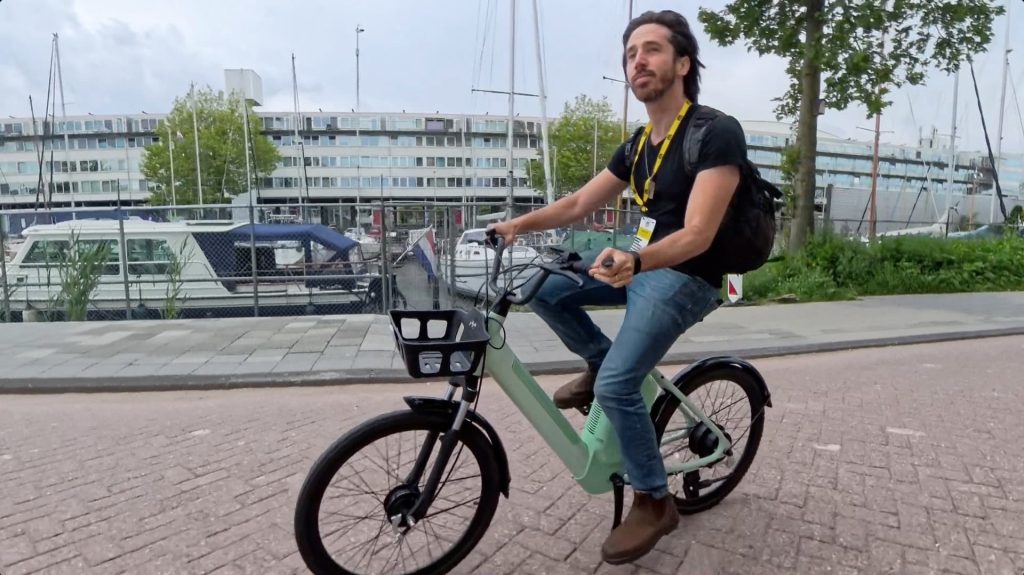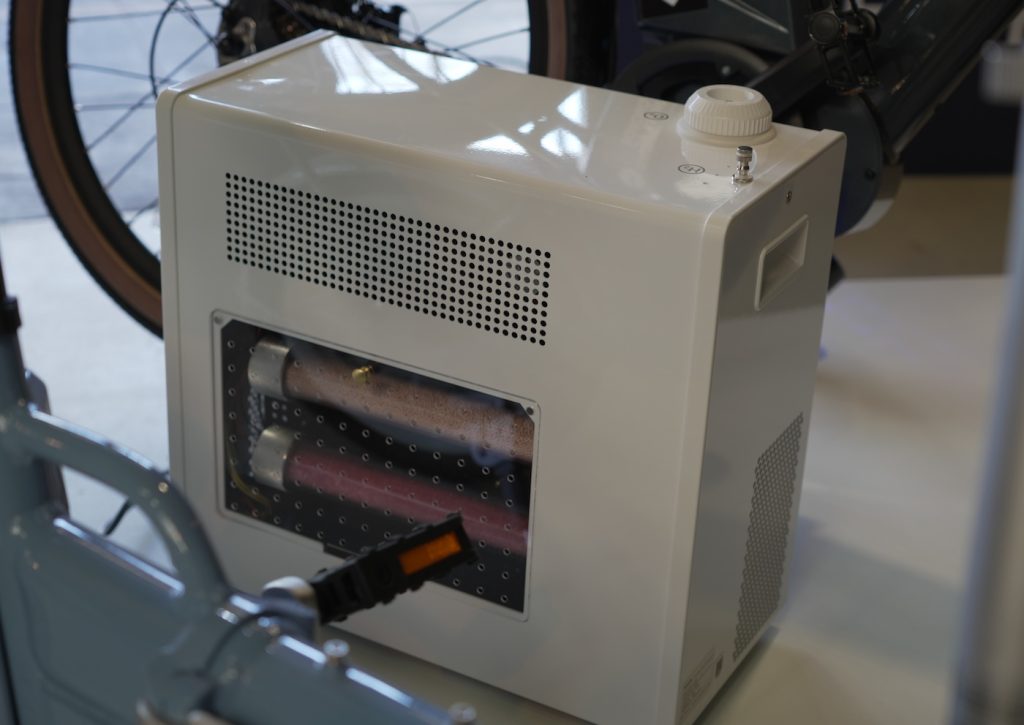
This past week, I attended the Micromobility Europe event in Amsterdam, where I saw many familiar company faces and several new ones in the broader micromobility world. One of the most fascinating new startups I saw at the show was Hydroride Europe AG, which showed off several hydrogen-powered bicycles and a small at-home hydrogen generator for “recharging” the bike by producing small bottles of hydrogen gas.
From a distance, the bikes don’t look much different than any other electric bike you’ve probably seen before.
And to be honest, they don’t even look that different from up close, either.
You’ll still spot a hub motor powering the wheel and what looks like a battery holder, either in the downtube or hidden in a rack-mounted unit. But when you turn the key and pop the “battery” lid, you’ll quickly realize it’s hiding a little green bottle instead of a blue shrink-wrapped battery.
Those little hydrogen tanks, around the size of a 500 mL water bottle, hold enough hydrogen for around 60 km or 36 miles of riding. They feed hydrogen into an on-board hydrogen fuel cell, which uses a chemical process to convert the hydrogen into electricity, with the only output being water.
That’s right, if the bottom of your bike wasn’t so filthy, you could probably put your lips up to it and drink.

My first ride on a hydrogen bike
After checking out the exhibit, I took one of the hydrogen bikes out for a test ride in the Amsterdam streets around the trade show.
I’m not sure what I was expecting, but it felt pretty much like…. any other European e-bike I’ve tried. The power was fine, modest but fine. The ride was comfortable. And it felt like a fairly conventional electric bike.
To be honest, I guess that’s the point. Hydrogen isn’t meant to be some revolutionary game changer for performance. At the end of the day, the motor is still a basic 250W e-bike hub motor. And thus, the ride feels like a basic 250W e-bike.
The main difference is where the energy is coming from. In this case, from a little white box that looks like a laser printer, yet is apparently an at-home hydrogen generator.
If anything, the most surprising thing about the ride itself was just how unsurprising it was. I didn’t really have to change anything about my riding since it’s still an electric bike, just not a battery electric bike.

E-bikes are already prolific. Why hydrogen?
It’s true, battery-powered electric bikes are everywhere. If there was ever going to be a hydrogen vs battery e-bike war, you’d think it would be over before it even began.
So why are we even still talking about hydrogen bikes? Well, there are still a few advantages over traditional e-bikes. Almost all electric bicycles these days use lithium-ion batteries, which usually require problematic or otherwise rare materials to produce. As much as battery makers have tried to limit the amount of such minerals, we’re often still beholden to suppliers from a handful of countries using sometimes unethical means to procure the necessary materials to produce these batteries.
Hydrogen, on the other hand, can be produced in your living room or kitchen using a small hydrogen generator. Heck, you can even buy one on Amazon if you want. It still requires electricity to power the electrolysis process, meaning you’re going to lose some energy along the way due to inefficiencies in the process. But just like how a wall charger doesn’t put 100% of the electricity that flows through it into your battery, there are always inefficiencies in energy transfers. And similarly to a wall charger for a battery e-bike, Hydroride’s electrolysis machine can be solar-powered, meaning you’re effectively using free energy from the sun to produce fuel. It’s literally a “just add water” process to generate your own fuel.
Once on the bike, the ride is as zero emissions as a battery-powered bicycle. Or, almost as zero emissions, as long as you don’t count the occasional drops of pure water produced by the hydrogen fuel cell on board the bike.

Who is this for?
It’s true, the company offers an at-home hydrogen generator and that means you could conceivably use a hydrogen bike like this as your daily rider. But as I learned at the booth, they’re more focused on B2B than B2C, with their main goal being bike and scooter sharing companies, not individual consumers like you and me.
And that makes more sense, in my opinion. Yes, I accept that hydrogen has unique advantages that batteries do not. But battery e-bikes have such a hold on the industry that I don’t see major changes coming there anytime soon.
But for sharing companies, those batteries are one of the biggest headaches of their industry. The single largest source of emissions for most scooter and bike-sharing services is the diesel-powered van that has to go around to swap batteries in these things. And so if you could fit larger hydrogen bottles on these bikes to give them more range (the small bottles already give scooters 100 km or 60 miles of range), or you could use local hydrogen generators for on-site bottle swaps, that could make a big impact.
It also removes the issue of charging hundreds of batteries at a storage depot and the resulting fire concerns related to those hundreds of batteries.
Top comment by Juan Diego CelemÃn Mojica
Undoubtely interesting, yet I can't but notice that the cost is missing.
If I know anything about hydrogen, these are currently 20x the cost of ordinary e-bikes, and could go down to 5-6x the cost once produced in larger numbers.
Hydrogen is awesome from an engineering POV. Not so much from a financial one.
To be fair, a quick check of the periodic table reminds me that hydrogen isn’t exactly the most inert of the gases, either. But we’ve come a long way from the days of the Hindenburg and are pretty good about safely controlling the storage and transfer of hydrogen, especially in small water bottle-sized packages.

What’s my verdict?
To be honest, I used to think hydrogen was dead on arrival for e-bikes. And I still am not very bullish on it gaining much market share. But now I at least see that it has real potential for certain specific niches.
Sharing and other fleet usage seems to be the best use case, since I don’t see it taking off for average consumers. I definitely see the advantages of hydrogen for a pizza shop with a fleet of delivery e-bikes that doesn’t want to deal with a tabletop full of charging batteries, or for a scooter sharing operation that doesn’t want the logistical nightmare of hundreds or thousands of volatile batteries in their warehouse.
But let’s just say I don’t think I’ll be riding a hydrogen-powered Trek or Gazelle bike soon.
FTC: We use income earning auto affiliate links. More.





Comments